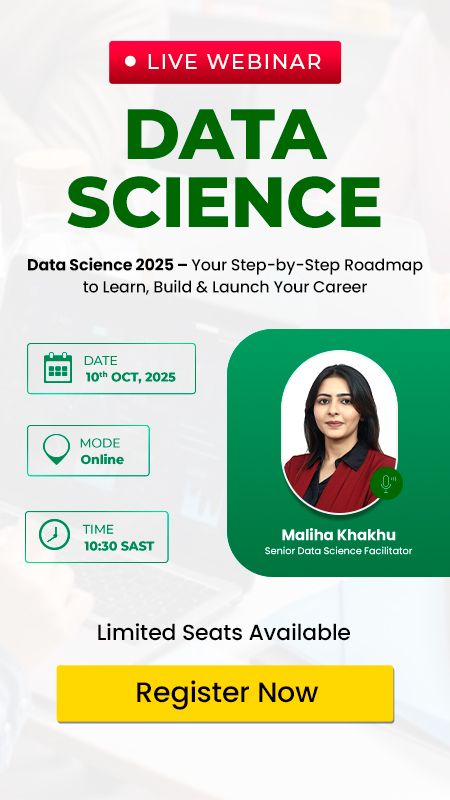What are the Best Steps to Master Data Science?
Data Science has become one of the most influential disciplines in today’s digital economy. With the rise of Artificial Intelligence, Big Data, and Predictive Analytics, organisations rely heavily on professionals who can analyse complex datasets and translate them into actionable insights. Industries such as healthcare, finance, retail, and technology are investing heavily in data-driven solutions, which has led to a growing demand for skilled data scientists. For professionals with undergraduate qualifications or work experience, and even for those with a Matric qualification, Data Science offers a clear pathway to career advancement.
In this article, we will cover the best steps to master Data Science and explore how structured courses can support your journey.
Step 1 – Build Strong Foundations in Mathematics and Statistics
Mathematics and Statistics are at the core of Data Science. Without strong foundations in these areas, it becomes challenging to apply concepts in machine learning or predictive modelling. Professionals should develop knowledge in areas such as Linear Algebra, Calculus, Probability, and Statistical Inference. These subjects form the backbone of algorithms used in artificial intelligence and data analytics.
It is worth noting that while some courses, such as the Digital Regenesys Certification Course in Data Science, do not have formal entry requirements, having a strong mathematical base can be highly beneficial for mastering complex concepts.
Practical applications include:
- Hypothesis testing – Essential for validating business assumptions.
- Regression analysis – Used in finance, marketing, and forecasting.
- Predictive modelling – Key to risk analysis and healthcare outcomes.
Core mathematical areas supporting Data Science:
- Linear Algebra – Underpins machine learning algorithms.
- Probability – Crucial for risk modelling and fraud detection.
- Calculus – Supports optimisation of algorithms.
- Statistics – Enables data interpretation and decision-making.
Read more on How to Study Data Science – A Complete Guide for Beginners here

Step 2 – Learn Programming for Data Science
Programming is an essential step in mastering Data Science. Python and R are the most widely used languages due to their flexibility, extensive libraries, and community support. Additionally, SQL is indispensable for database management and data retrieval.
Programming is not only about writing code but also about problem-solving and automating workflows. For professionals transitioning into Data Science, beginning with Python and gradually advancing to libraries such as Pandas, NumPy, and Scikit-learn is recommended.
Recommended progression:
- Beginner – Python basics and data types.
- Intermediate – Libraries for data wrangling and analysis.
- Advanced – Machine learning frameworks like TensorFlow or PyTorch.
Step 3 – Develop Expertise in Data Handling and Databases
Handling data is a fundamental skill for any data scientist. Professionals must be able to work with both structured and unstructured data. Structured data is typically found in relational databases, while unstructured data includes text, images, and video.
Databases such as MySQL and PostgreSQL are used for structured data, while MongoDB and Cassandra manage unstructured datasets. Beyond storage, data cleaning and preprocessing are vital to ensure accuracy and reliability in analysis.
Some of the main areas of expertise include:
- Data extraction and transformation.
- SQL queries for structured data.
- NoSQL databases for unstructured data.
- Data cleaning to eliminate duplicates and errors.
Step 4 – Gain Proficiency in Data Visualisation and Business Communication
The ability to communicate insights is what separates effective data scientists from technical analysts. Data visualisation tools help professionals transform complex datasets into meaningful insights for business leaders.
Tools such as Tableau, Power BI, Matplotlib, and Seaborn enable professionals to create dashboards, interactive reports, and visual summaries. This ensures stakeholders can understand trends and take informed decisions.
Practical applications of data visualisation include:
- Finance – Conducting risk analysis, illustrating stock market movements, and presenting financial forecasts clearly.
- Healthcare – Monitoring patient outcomes, tracking treatment effectiveness, and visualising medical research findings.
- Marketing – Identifying customer segments, mapping behaviour patterns, and communicating campaign performance to stakeholders.
Read more on Data Science Certificate Online Guide for South Africans – Pricing, Skills, and Recognition here
Step 5 – Master Machine Learning and Artificial Intelligence Concepts
Machine learning (ML) and Artificial Intelligence (AI) represent the advanced stages of Data Science mastery. Professionals should be familiar with supervised, unsupervised, and reinforcement learning. These concepts power applications like recommendation systems, fraud detection, and predictive analytics.
Steps to mastering ML and AI:
- Understand supervised learning (classification, regression).
- Apply unsupervised learning (clustering, dimensionality reduction).
- Explore deep learning and reinforcement learning.
- Learn how to evaluate models and prevent bias in results.
For professionals aiming to build AI expertise, exploring advanced courses such as the Digital Regenesys Certification Course in Artificial Intelligence provides structured pathways to develop these skills.
Step 6 – Work with Big Data and Cloud Platforms
As datasets grow in volume and complexity, understanding big data and cloud computing becomes indispensable. Platforms such as Hadoop and Spark allow professionals to process massive amounts of data efficiently. Meanwhile, cloud platforms like AWS, Azure, and Google Cloud provide scalable solutions for data storage and advanced analytics.
Integrating big data with cloud skills helps professionals:
- Handle large-scale data processing.
- Deploy machine learning models at scale.
- Enhance collaboration in global business environments.
Read more on Is Data Science Hard? Explore Learning Paths and Required Skills here
Step 7 – Apply Data Science through Projects and Case Studies
The true test of Data Science skills lies in applying them to real-world challenges. Practical projects and case studies bridge the gap between theoretical knowledge and industry expectations. Platforms such as Kaggle, academic research projects, or domain-specific case studies provide excellent opportunities to build confidence and credibility. These experiences not only strengthen technical ability but also showcase problem-solving skills that employers value.
Tips for building a strong professional portfolio include:
- Work across multiple domains – Include projects in finance, healthcare, and retail to show versatility.
- Highlight the process – Document challenges faced, approaches taken, and how you resolved them.
- Communicate results effectively – Present insights in a clear, business-oriented format that decision-makers can understand.
Step 8 – Stay Updated with Trends and Continuous Learning
Data Science is a rapidly evolving discipline, with new tools, frameworks, and practices emerging every year. To remain competitive, professionals must adopt a mindset of continuous learning. Staying updated with developments such as MLOps, AI ethics, and automated machine learning ensures that skills remain relevant and future-focused. Engaging with the latest trends also builds thought leadership and positions professionals as adaptable problem-solvers in dynamic industries.
Practical ways to keep up with developments include:
- Join professional communities and forums – Engage with peers on platforms that share ideas and practical solutions.
- Participate in workshops, webinars, and conferences – Gain insights directly from industry leaders and experts.
- Follow research publications and industry reports – Track innovations and apply fresh perspectives to your work.
Step 9 – Pursue Structured Academic or Professional Courses
Self-learning is valuable, but structured programmes offer credibility, guided learning, and recognised certification. For professionals with prior experience or qualifications, enrolling in advanced programmes creates opportunities to deepen expertise and accelerate career growth.
Digital Regenesys offers a Data Science course that covers programming, machine learning, data handling, and practical applications. The course is designed for professionals who want to transition into Data Science roles or expand their current skill set with recognised training.

Conclusion
Mastering Data Science is not a single step but a structured journey that combines mathematics, programming, data handling, visualisation, machine learning, and practical application. For professionals, building these competencies creates pathways to senior roles in finance, healthcare, technology, and beyond.
Structured courses, such as the Digital Regenesys Certification Course in Data Science, provide the guidance, tools, and practical training needed to transform ambition into expertise. By combining theoretical learning with applied projects, learners can position themselves as valuable contributors in a data-driven world.
Start your Data Science journey today with Digital Regenesys and take a decisive step towards advancing your career.
What are the Best Steps to Master Data Science? – FAQs
What are the prerequisites for studying Data Science?
While some courses, including Digital Regenesys programmes, do not require formal entry qualifications, a strong foundation in mathematics and logical reasoning is highly beneficial.
How long does it take to master Data Science?
On average, professionals can develop core competencies within 6–12 months of structured learning, but mastery requires continuous practice and lifelong learning.
Do I need to know programming before starting?
No, beginners can start without prior coding knowledge. Languages like Python are designed for accessibility, and structured courses provide step-by-step guidance.
What industries hire data scientists?
Data scientists are in demand across finance, healthcare, retail, technology, education, and government, where data-driven decision-making is integral.
Is Data Science difficult to learn?
It can be challenging due to its interdisciplinary nature, but with the right resources, structured learning, and consistent practice, professionals can build expertise effectively.











